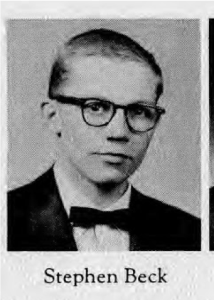By Ann Reich
Freedom of the press has been under fire since it was included in the First Amendment. Even today, ethical questions arise around the country concerning the right to release information. In critical moments news organizations have to weigh the consequences before publishing sensitive material.

Neal A. Maxwell, as pictured in The Daily Utah Chronicle on January 17, 1962.
The early 1960s were a time of tumult for the United States. The country was in the midst of an indefinite cold war and problems with Cuba were heating up. In April of 1961 the Bay of Pigs invasion during President Kennedy’s term was a failure, and the press released information about the defeat. (history.com) On January 17, 1962, The Daily Utah Chronicle in the article, “Press Freedom’s Future,” said, “Presently the threat by the communist nations to the United States has again caused people to challenge freedom of the press.” It was a crucial time in history for the press, and freedom of the press was a significant topic in the journalism community.
On January 17, 1962, The University of Utah held a Great Issues Forum. At this event Neal A. Maxwell, the assistant to President A. Ray Olpin, discussed an essay he wrote titled, “Is Freedom of the Press Compatible with National Security?” After Maxwell, Hays Gorey, Salt Lake Tribune editor, and William B. Smart, head of the Deseret News editorial page, spoke on the same topic. (The Daily Utah Chronicle, p. 1)
In his essay, Maxwell analyzed the government’s relationship with the press, and his thoughts on a free press. Many times throughout history, the U.S. government has made a pact with the press to suspend fighting until a war or dangerous time is over. Maxwell argued that the Cold War was different and this suspension agreement could not be made. There was no end in sight during the Cold War, and the people needed information. (Maxwell, p. 46)
Maxwell argued that national security, especially with the military, was better with a free press. If the people know about the strengths, weaknesses, and plans in the military, then the executive branch would be presented with more choices regarding taking action. (Maxwell, p. 50)

Hays Gorey, a University of Utah alumnus, was pictured in The Daily Utah Chronicle on January 17, 1962.
Hays Gorey responded to Maxwell’s article. Gorey’s view agreed with Maxwell’s and he said that if the U.S. had no free press then it “would not be America at all.” (Gorey, p. 54) However, the press could cause some short-term harm to national security, but it is never lasting. While reporting on the mistakes of the U.S. could make the country weak in the moment, it would strengthen the country in the long run. The government would learn from their mistakes and would be less likely to repeat history if it was all documented by the press. Gorey was overall concerned with the government lasting. Free press might hurt the current government, but it has a more positive long-term outcome.
William B. Smart also wrote a response. Much of what he said aligned with Maxwell and Gorey: the free press had done well to protect national security. At the time of this speech, the country was in the midst of fighting communism. Smart mentioned President Kennedy’s fear of becoming like the enemy the country was fighting. The free press keeps the U.S. a democracy and stays away from too many governmental censorship.

William B. Smart, pictured in The Daily Utah Chronicle on January 17, 1962, was head of the Deseret News editorial page.
Another important topic discussed was the fear caused by the press. Gorey claimed that it is better to know all of the horrifying events happening, then to be left afraid in the unknown. Maxwell brought up fear as a reason the government may push against the free press. However, Smart disagreed. In his comments he mentioned that the American citizens were “far more tough-minded” than what Maxwell implied. (Smart, p. 58)
Even though many events in the 1960s were mentioned by these speakers, their comments have been relevant throughout history. The Washington Post stated, “governments around the world are becoming more sophisticated in their efforts to censor expression.” (Rezaian) An increase in press censorship is largely due to the internet’s role in spreading information. Although the government will always attempt censorship in the interest of national security, freedom of the press will always be necessary.
Ann Reich is a senior at the University of Utah. Her major is communication with an emphasis in journalism.
Primary Sources
Neal A. Maxwell, “Is Freedom of the Press Compatible With National Security?” in Great Issues Concerning Freedom, ed. Waldemer P. Read (Salt Lake City: University of Utah, 1962), 41-54.
Hays Gorey, “Comments” in Great Issues Concerning Freedom, ed. Waldemer P. Read (Salt Lake City: University of Utah, 1962), 54-57.
William B. Smart, “Comments” in Great Issues Concerning Freedom, ed. Waldemer P. Read (Salt Lake City: University of Utah, 1962), 57-60.
“Press Security To Theme Great Issues,” The Daily Utah Chronicle, January 16, 1962, 1.
Jackie Back, “Maxwell, Newsmen Set Examination Of Press,” The Daily Utah Chronicle, January 17, 1962, 1.
“Press Freedom’s Future,” The Daily Utah Chronicle, January 17, 1962, 2.
“Great Issues Airs Free Press In U.S.,” The Daily Utah Chronicle, January 18, 1962, 1.
“Vice President of U. Links Press Freedom, Security,” The Salt Lake Tribune, January 18, 1962, 24.
Secondary Sources
Editors, “Cuban Missile Crisis,” History.com.
Rezaian, Jason. “Dictators and the Internet: A Love Story,” The Washington Post, September 10, 2019.


